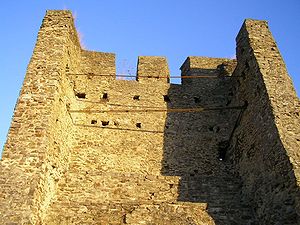Dasburg (castle)
| The castle | ||
|---|---|---|
|
Defense tower in 2007 |
||
| Alternative name (s): | Dasburg Castle, Daysberg Castle | |
| Creation time : | Early 13th century | |
| Castle type : | Hilltop castle | |
| Conservation status: | Wall remains | |
| Standing position : | Count | |
| Place: | The castle | |
| Geographical location | 50 ° 2 '49 " N , 6 ° 7' 56.5" E | |
| Height: | 356 m above sea level NN | |
|
|
||
The Dasburg is the ruin of a hilltop castle in the South Eifel in the German-Luxembourgish nature park at 356 m above sea level. NN high hill near the municipality Dasburg an der Our in the Eifelkreis Bitburg-Prüm in Rhineland-Palatinate .
history
The castle was probably built at the beginning of the 13th century as a fortification and refuge . In 1222 it is mentioned for the first time as "Daysberhc castrum" in the commentary on the Prümer Urbar , which the Prümer ex-Abbot Caesarius von Milendonk made in 1222.
The counts had the Dasburg and the rule as a fief from the Prüm Abbey . In return, the Viandener had to grant protection to the abbey. Due to this situation, Dasburg always had well-known and large noble houses in their name: Vianden, von Sponheim, Nassau and Oranien. Even today, the Dutch king has the addition "Herr von Dasburg" in his title.
In 1417 the castle was handed over to the Counts of Nassau-Dillenburg , owned by King Wilhelm of Spain from 1580 to 1604, and from the 17th to 18th centuries it was owned by Nassau-Orange . In 1625 the clergyman at the time, Pastor Jakob Pott, lists 35 houses by name. At that time, the Dasburg rulership fulfilled important strategic tasks to protect the Count Castle Vianden by securing the thoroughfare from the west. The rule included the dairies Dasburg, Daleiden and at times Binscheid and Harspelt . As the seat of rule, Dasburg had its own court consisting of mayors and lay judges. In 1794 it was occupied by the French revolutionary troops . This also resulted in the clapper war . The leader of the clapper war army was the then Dasburg castle hunter Karl Bormann. In 1813 General Oudinot (he received the Dasburg for his military services from Napoleon ) had the Dasburg Castle auctioned by the then notary Dupont.
After the Second World War, the castle ruins went to the state of Rhineland-Palatinate and in 1965 was handed over to the state palace administration.
The castle is currently being restored. After the renovation work has been completed, the castle will be leased. The lease is being put out to tender as there are already several interested parties.
On January 22, 2012, larger parts of the outer masonry and the foundations of the round tower came loose and slipped in the direction of the B 410 passing by .
investment
From the medieval castle complex with a large dungeon , the foundations of the inner defensive wall , parts of the outer defensive wall with two half towers, remains of the entrance gate and the north side of the 20 m high defensive tower , which was the center of the likely Staufer core castle , as well as a corridor along the surrounding wall have been preserved which originally had a bridge on its northern narrow side and was broken through by a gate and some half towers.
Web links
- Entry about Dasburg in the scientific database " EBIDAT " of the European Castle Institute
- Dasburg on the website of the General Directorate for Cultural Heritage Rhineland-Palatinate
Single receipts
- ^ Heinrich Beyer : Mittelrheinisches Urkundenbuch , Volume I, Coblenz: Hölscher, 1860, p. 159 ( dilibri.de )
- ^ Fritz-Peter Linden: Leaseholder ante Portas Prümer Zeitung, January 18, 2012.
- ^ Dasburg: Masonry on the round tower collapses , Trierischer Volksfreund from January 22, 2012, accessed on January 20, 2016.







